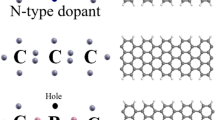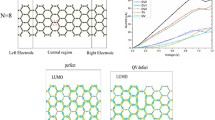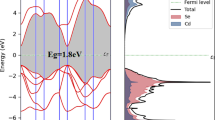Abstract
Density functional theory (DFT) has been used to study the structure and electronic properties of boron-doped armchair germanene nanoribbons materials. The doped configurations are all stable in the electric field by the σ bond and the π bond. The doped structures can be semi-conductive or semi-metallic depending on the doping substitution positions. The doping configuration B:Ge = 1:1 proved to be superior and stable in the electric field, and the doping changed this structure to become planar. With three different directions of electric field, the horizontal electric field has the most influence on the geometric structure, multi-orbit hybridization as well as the spatial charge distribution of the doped systems. The magnetization of the systems changes with the changing direction of an electric field, anti-ferromagnetic structures are found in meta-configuration and ortho-configuration with longitudinal electric fields, and 1–1 configuration with perpendicular electric fields and horizontal electric fields. The ortho-configuration with an electric field of 0.5 V/m with an extended band gap of 0.69 eV is perfectly applicable in room-temperature field-effect transistors; other configurations have potential in nanoscale applications.








Similar content being viewed by others
References
Geim AK, Novoselov KS (2007) The rise of graphene. Nat Mater 6:183–191. https://doi.org/10.1038/nmat1849
Peres NMR, Ribeiro RM (2009) Focus on graphene. New J Phys 11:095002. https://doi.org/10.1088/1367-2630/11/9/095002
Stauber T, Peres NMR, Guinea F (2007) Electronic transport in graphene: a semiclassical approach including midgap states. Phys Rev B 76(20):205423. https://doi.org/10.1103/PhysRevB.76.205423
Dean CR, Young AF, Cadden-Zimansky P et al (2011) Multicomponent fractional quantum Hall effect in graphene. Nat Phys 7(9):693–696. https://doi.org/10.1038/nphys2007
Cooper DR, D’Anjou B, Ghattamaneni, et al (2012) Experimental review of graphene. ISRN Condensed Matter Physics 2012:1–56. https://doi.org/10.5402/2012/501686
Dávila M, Xian L, Cahangirov S, Rubio A, Le Lay G (2014) Germanene: a novel two dimensional germanium allotrope akin to graphene and silicene. New J Phys 16(9):095002. https://doi.org/10.1088/1367-2630/16/9/095002
Aufray B, Kara A, Vizzini S, Oughaddou H, Léandri C, Ealet B, Le Lay G (2010) Graphene-like silicon nanoribbons on Ag(110): a possible formation of silicene. Appl Phys Lett 96:183102. https://doi.org/10.1063/1.3419932
De Padova P, Quaresima C, Ottaviani C, Sheverdyaeva PM, Moras P, Carbone C, Topwal D, Bruno, et al (2010) Evidence of graphene-like electronic signature in silicene nanoribbons. Appl Phys Lett 96:261905. https://doi.org/10.1063/1.3459143
Guy LL, De Padova P, Resta A, Bruhn T, Vogt P (2012) Epitaxial silicene: can it be strongly strained. J Phys D: Appl Phys 45:392001. https://doi.org/10.1088/0022-3727/45/39/392001
De Pavoda P, Quaresima C, Olivieri B, Perfetti P, Le Lay G (2011) sp2 -like hybridization of silicon valence orbitals in silicene nanoribbons. Appl Phys Lett 98:081909. https://doi.org/10.1063/1.3557073
Fleurence A, Friedlein R, Ozaki T, Kawai H, Wang Y, Yamada-Takamura Y (2012) Phys Rev Lett 108:245501. https://doi.org/10.1103/physrevlett.108.245501
Vogt P, De Padova P, Quaresima C, Frantzeskakis JAE, Asensio MC, Resta A, Ealet B, Le Lay G (2012) Two dimensional Si layer epitaxied on LaAlO3(111) substrate: RHEED and XPS investigations. Phys Rev Lett 108:155501. https://doi.org/10.1088/1742-6596/491/1/012003
Li L, Lu S-Z, Pan J, Qin Z, Wang Y-Q, Wang Y, Cao G, Du S, Gao H-J (2014) Buckled germanene formation on Pt(111). Adv Mater 26:4820. https://doi.org/10.1002/adma.201400909
Dávila M E, Xian L, Cahangirov S, Rubio A and Le Lay G (2014) Germanene: a novel two-dimensional germanium allotrope akin to graphene and silicone.New J. Phys. 16: 095002. https://doi.org/10.1088/1367-2630/16/9/095002
Bampoulis P, Zhang L, Safaei A, van Gastel R, Poelsema B andZandvliet H J W (2014) Germanene termination of Ge2Pt crystals on Ge(110). J Phys Condens Matter 26 (2014) 442001. https://doi.org/10.1088/0953-8984/26/44/442001
Derivaz M, Dentel D, Stephan R, Hanf M-C, Mehdaoui A, Sonnet P, Pirri C (2015) Continuous germanene layer on Al(111). Nano Lett 15:2510. https://doi.org/10.1021/acs.nanolett.5b00085
Acun A, Zhang L, Bampoulis P, Farmanbar M, van Houselt A, Rudenko AN, Lingenfelder M, Brocks G, Poelsema B, Katsnelson MI, Zandvliet HJW (2015) Germanene: the germanium analogue of graphene. J Phys: Condens Matter 27(44):443002. https://doi.org/10.1088/0953-8984/27/44/443002
Novoselov KS, Andreeva DV, WencaiRen and Guangcun Shan, (2019) Graphene and other two-dimensional materials. Front Phys 14:13301. https://doi.org/10.1007/s11467-018-0835-6
Mermin ND (1968) Crystalline order in two dimensions. Phys Rev 176:250. https://doi.org/10.1103/PhysRev.176.250
Derivaz M, Dentel D, Stephan R, Hanf M-C, Mehdaoui A, Sonnet P, Pirri C (2015) Continuous germanene layer on Al (111). Nano Letters ACS Publications 15(4):2510–2516. https://doi.org/10.1021/acs.nanolett.5b00085
Li L, Shuang-zan Lu, Pan J, Qin Z, Wang Y-q, Wang Y, Cao G-y, Shixuan Du, Gao H-J (2014) Buckled germanene formation on Pt(111). Adv Mater 26(28):4820–4824. https://doi.org/10.1002/adma.201400909
Kyozaburo Takeda and Kenji Shiraishi (1994) Theoretical possibility of stage corrugation in Si and Ge analogs of graphite. Phys Rev B 50(1994):14916. https://doi.org/10.1103/PhysRevB.50.14916
Guzmán-Verri GG, L. C. Lew Yan Voon, (2007) Electronic structure of silicon-based nanostructures. Phys Rev B 76:075131. https://doi.org/10.1103/PhysRevB.76.075131
Cahangirov S, Topsakal M, Aktürk E, Şahin H, Ciraci S (2009) Two- and one-dimensional honeycomb structures of silicon and germanium. Phys Rev Lett 102:236804. https://doi.org/10.1103/PhysRevLett.102.236804
Scalise E, Houssa M, van den Geoffrey Pourtois B, Broek V, Afanas’ev & André Stesmans, (2013) Vibrational properties of silicene and germanene. Nano Res 6:19–28. https://doi.org/10.1007/s12274-012-0277-3
Houssa M, Pourtois G, Afanasév VV, Stesmans A (2010) Electronic properties of two-dimensional hexagonal germanium. Appl Phys Lett 96:082111. https://doi.org/10.1063/1.3332588
Roome NJ, Carey JD (2014) Beyond graphene: stable elemental monolayers of silicene and germanene. ACS Appl Mater Interfaces 6:7743. https://doi.org/10.1021/am501022x
Nijamudheen A, Bhattacharjee R, Choudhury S, Datta A (2015) Electronic and chemical properties of germanene: the crucial role of buckling. J Phys Chem C 119:3802. https://doi.org/10.1021/jp511488m
Trivedi S, Srivastava A, Kurchania R (2014) Silicene and germanene: a first principle study of electronic structure and effect of hydrogenation-passivation. J Comput Theor Nanosci 11:781. https://doi.org/10.1166/jctn.2014.3428
Cai Y, Chuu C-P, Wei CM, Chou MY, Stability and electronic properties of two-dimensional silicene and germanene on grapheme, (2013) Phys Rev B 88:245408. https://doi.org/10.1103/PhysRevB.88.245408
Ye M, Quhe R, Zheng J, Ni Z, Wang Y, Yuan Y, Tse G, Shi J, Gao Z, Lu J (2014) Tunable band gap in germanene by surface adsorption. Physica E 59:60–65. https://doi.org/10.1016/j.physe.2013.12.016
Li X, Wu S, Zhou S, Zhu Z (2014) Structural and electronic properties of germanene/MoS2 monolayer and silicene/MoS2 monolayer superlattices. Nanoscale Res Lett 9:110. https://doi.org/10.1186/1556-276x-9-110
Boettger JC, Trickey SB (2007) First-principles calculation of the spin-orbit splitting in graphene. Phys Rev B 75:121402(R). https://doi.org/10.1103/PhysRevB.75.121402
Gmitra M, Konschuh S, Ertler C, Ambrosch-Draxl C, Fabian J (2009) Band-structure topologies of graphene: spin-orbit coupling effects from first principles. Phys Rev B 80(2009):235431. https://doi.org/10.1103/PhysRevB.80.235431
Samir Abdelouahed A, Ernst J, Henk IV, Maznichenko, and I. Mertig, (2010) Spin-split electronic states in graphene: effects due to lattice deformation, Rashba effect, and adatoms by first principles. Phys Rev B 82:125424. https://doi.org/10.1103/PhysRevB.82.125424
Liu C-C, Feng W, Yao Y (2011) Quantum spin hall effect in silicene and two-dimensional germanium. Phys Rev Lett 107:076802. https://doi.org/10.1103/PhysRevLett.107.076802
Ye X-S, Shao Z-G, Zhao H, Yang L, Wang C-L (2014) Intrinsic carrier mobility of germanene is larger than graphene’s: first-principle calculations. RSC Adv 4:21216. https://doi.org/10.1039/C4RA01802H
Han W, Kawakami RK, Gmitra M, Fabian J (2014) Graphene spintronics. Nat Nanotechnol 9:794–807. https://doi.org/10.1038/nnano.2014.214
Konschuh S, Gmitra M, Fabian J (2010) Tight-binding theory of the spin-orbit coupling in graphene. Phys Rev B 82:245412. https://doi.org/10.1103/PhysRevB.82.245412
Joelson C. Garcia, Denille B. de Lima, Lucy V. C. Assali, and João F. Justo (2011) Group IV graphene- and graphane-like nanosheets. J. Phys. Chem. C 115 (27): 13242–13246. https://doi.org/10.48550/arXiv.1204.2875
Xia W, Hu W, Li Z, Yang J (2014) A first-principles study of gas adsorption on germanene. Phys Chem Chem Phys 16(41):22495–22498. https://doi.org/10.1039/C4CP03292F
Ghosal S, Bandyopadhyaya A, Jana D (2020) Electric field induced band tuning, optical and thermoelectric responses in tetragonal germanene: a theoretical approach. Phys Chem Chem Phys 35(22):19957–19968. https://doi.org/10.1039/D0CP03892J
Raad Chegel and Somayeh Behzad (2020) Tunable electronic, optical, and thermal properties of two- dimensional germanene via an external electric field. Scientific Reports volume 10 (704): 1–12. https://www.nature.com/articles/s41598-020-57558-x
Monshi MM, S. M. Aghaeiand I. Calizo, (2017) Edge functionalized germanene nanoribbons: impact on electronic and magnetic properties. RSC Adv 31(7):18900–18908. https://doi.org/10.1039/C6RA25083A
Hoang Van Ngoc, Trieu Quynh Trang, Air Xayyadeth and Chu Viet Ha (2021) Doping two boron atoms in germanene nanoribbons in an external electric field.J. Phys.: Conf. Ser. 2070: 012130. https://doi.org/10.1088/1742-6596/2070/1/012130
Kresse G, Furthmüller J (1996) Efficient iterative schemes for ab initio total-energy calculations using a plane-wave basis set. Phys Rev B 54:11169. https://doi.org/10.1103/PhysRevB.54.11169
Perdew JP, Burke K, Ernzerhof M (1996) Generalized gradient approximation made simple. Phys Rev Lett 77:3865. https://doi.org/10.1103/PhysRevLett.77.3865
Mortazavi B, Rahamanг O, Makaremi M, Dianat A, Cuniberti G, Rabczuk T (2017) First-principles investigation of mechanical properties of silicene, germanene and stanene. Physica E 87:228–232. https://doi.org/10.1016/j.physe.2016.10.047
Gupta SK, Singh D, Rajput K, Sonvane Y (2016) Germanene: a new electronic gas sensing material. RSC Adv 6(104):102264. https://doi.org/10.1039/C6RA11890A
Hussain T, Kaewmaraya T, Chakraborty S, Vovusha H, Amornkitbamrung V, Ahuja R (2018) Defected and functionalized germanene-based nanosensors under sulfur comprising gas exposure. ACS Sensors 3(4):867. https://doi.org/10.1021/acssensors.8b00167
Shiraz AK, Goharrizi AY, Mehrihamidi S (2019) The electronic and optical properties of armchair germanene nanoribbons. Physica E 107:150–153. https://doi.org/10.1016/j.physe.2018.11.019
Acknowledgements
This research used resources of the high-performance computer cluster (HPCC) at Thu Dau Mot University (TDMU), Binh Duong Province, Vietnam.
Funding
This research is funded by Thu Dau Mot University under grant number DT.21.2.045.
Author information
Authors and Affiliations
Contributions
Hoang Van Ngoc, Trieu Quynh Trang: conceptualization, methodology, software, investigation, and formal analysis. Hoang Van Ngoc, Chu Viet Ha: methodology, review, editing, and writing.
Corresponding author
Ethics declarations
Competing interests
The authors declare no competing interests.
Additional information
Publisher's note
Springer Nature remains neutral with regard to jurisdictional claims in published maps and institutional affiliations.
Rights and permissions
Springer Nature or its licensor (e.g. a society or other partner) holds exclusive rights to this article under a publishing agreement with the author(s) or other rightsholder(s); author self-archiving of the accepted manuscript version of this article is solely governed by the terms of such publishing agreement and applicable law.
About this article
Cite this article
Van Ngoc, H., Trang, T.Q. & Ha, C.V. Boron-doped armchair germanene nanoribbons with a width of six atoms in an external field: a DFT study. J Mol Model 29, 20 (2023). https://doi.org/10.1007/s00894-022-05430-2
Received:
Accepted:
Published:
DOI: https://doi.org/10.1007/s00894-022-05430-2




